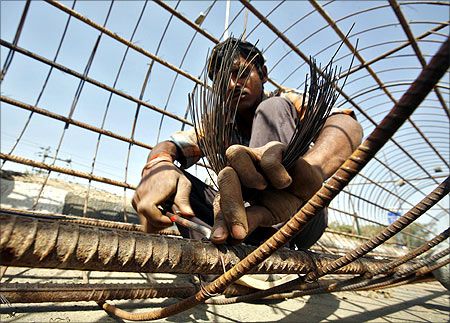 | « Back to article | Print this article |
 The Central Statistical Organisation says that industry is firing on all cylinders; all other indicators suggest it is sluggish at best, notes Ishan Bakshi
The Central Statistical Organisation says that industry is firing on all cylinders; all other indicators suggest it is sluggish at best, notes Ishan Bakshi
The controversy over the new gross domestic product series refuses to die down.
Going by the latest estimates, the noon-farm sector grew an impressive 9.2 per cent in the third quarter.
One would be forgiven for feeling confused, but if the economy was truly growing at such breathtaking speed, what explains the growing clamour for a fiscal stimulus?
The confusion over the numbers is because of the growing chasm between the Central Statistical Office's GDP estimates and other key economic indicators which suggest sluggish growth at best.
The greatest disconnect lies in the estimates of industrial growth.
According to CSO, industry grew at a scorching pace of 8.9 per cent in the third quarter (October to December 2015), with manufacturing clocking 12.6 per cent growth.
In comparison, the index of industrial production grew a mere 1.5 per cent, with manufacturing registering growth of only 0.9 per cent, nowhere near the GDP number. The divergence between the two estimates is truly confounding.
To be fair, there are many reasons for the divergent trends.
IIP measures volume growth, while GDP measures growth in value added.
The base years of the two indicators are different. But considering the backdrop of growing concerns of hollowing out of domestic manufacturing, the GDP numbers are extraordinarily high.
Add to that the fact that Chennai, a major manufacturing hub, came to a virtual standstill due to the floods during this period and the numbers become truly puzzling.
Part of the explanation for the divergence rests on how the GDP data is calculated.
According to National Statistical Commission Chairman Pronab Sen, "The manufacturing sector has two components.
"The first component is the corporate data which is based on advanced filing of companies in stock exchanges, while the second non-corporate component is based on IIP, and you take a weighted average of that."
Companies account for 65 per cent of manufacturing.
In order to arrive at a comparable estimate of the first component, Business Standard estimated gross value added for over 1,000 companies.
Gross value added is estimated as profits minus interest payments plus depreciation and compensation to employees.
According to this estimate, GVA grew 3.8 per cent over the April to December 2015 period.
Value added has grown even though sales have gone down because profits have grown because of the declining input (commodity) costs and higher wages and depreciation.
By comparison, CSO's estimate shows that GVA grew 5.7 per cent.
But with IIP growing at 3.1 per cent over the same period, the numbers simply don't add up.
The biggest disconnect lies in the second quarter numbers.
According to an analysis of over 1,000 companies, GVA contracted by 0.8 per cent in the second quarter.
This contraction is in large part because of steel companies reporting losses and Tata motors registering a loss because of a charge of Rs 2,493 crore (Rs 24.93 billion) on account of the vehicles damaged at the Tianjin Port explosion.
Under the new series, GVA at current prices grew 4 per cent in the second quarter.
While it is possible that part of the difference is offset due to higher growth of IIP, the index grew at 4.8 per cent in the second quarter, even after accounting for this it is difficult to reconcile the two estimates.
It's all froth
Echoing the scepticism over the growth numbers, CARE Chief Economist Madan Sabnavis says that the "top 500 companies account for roughly 75 per cent of overall corporate performance.
It is difficult to believe that if these companies are doing badly then the remaining 495,000 that CSO tracks are doing better."
While greater clarity over how exactly IIP and corporate data are incorporated to arrive at the quarterly estimates is desirable, the fundamental question is whether the trend of muted volume growth and high value added is sustainable? Is it really possible for value added to continue growing at 9 plus per cent, with volumes barely growing?
Economists are doubtful.
"This pickup in value addition may reflect the downtrend in inputs costs, may not sustain going forward without a pickup in volume growth" says ICRA Senior Economist Aditi Nayar.
While compensation to employees and depreciation will continue to be positive, profit growth is likely to suffer with commodity prices unlikely to decline further.
Thus, in the absence of a sustained pick up in volumes, GVA is likely to be muted going forward.
What is equally worrying is that despite CSO data showing a pickup in GVA and a decline in the cost of capital, investments aren't really taking off. According to the new GDP series, gross fixed capital formation declined to an alarming 27.8 per cent in the third quarter, from 30.9 per cent in the first quarter.
The capital goods component of IIP, which indicates investment demand in the economy, contracted 9.96 per cent in the third quarter, giving economists good reasons to fret.
This trend could be interpreted to mean that companies expect profit growth to decline in the future which suggests that concerns over lack of demand continue to weigh heavily on them.
Rather than giving more clarity about the state of the economy, the latest GDP estimates have raised more questions about the sustainability of this 'recovery'.
Image: A labourer works on reinforcing bars at a construction site to build a bridge. Photograph: Amit Dave/Reuters
The image is used for representational purpose only.